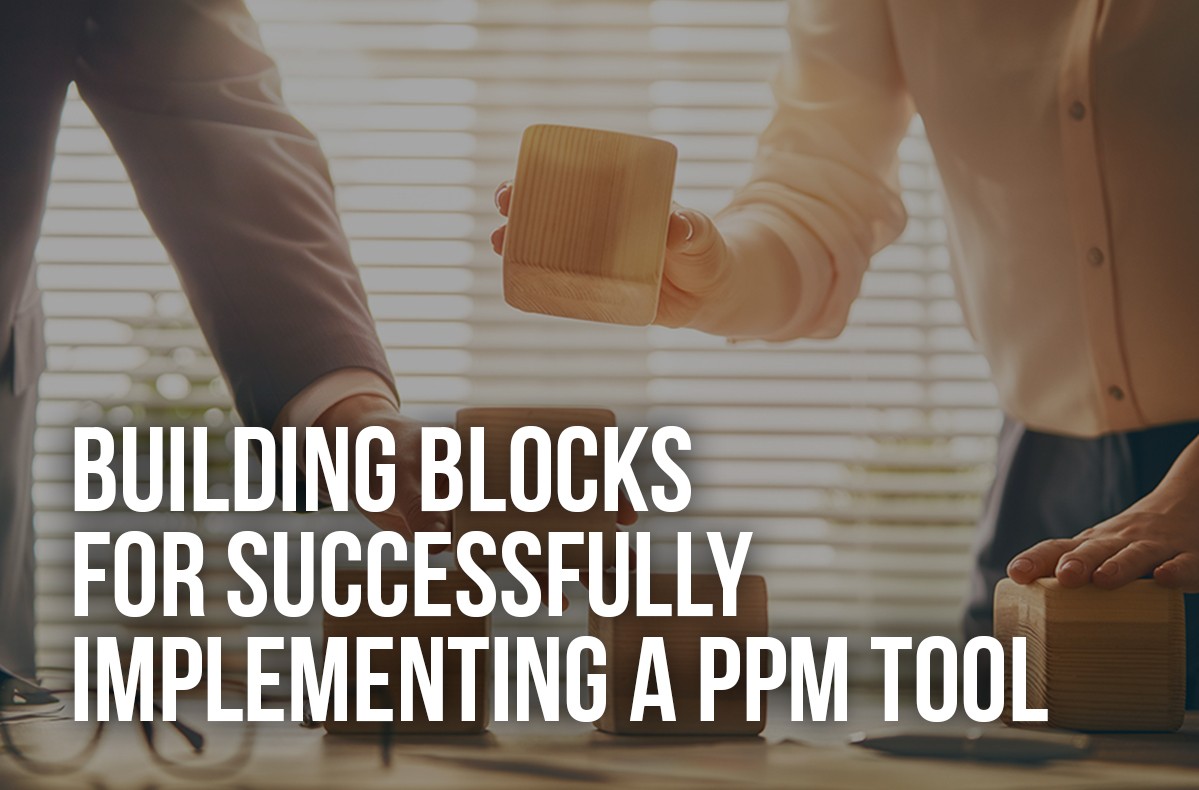
During my 10 years of PMO practice experience I’ve heard differing views on the implementation of PPM (Project Portfolio Management) tools:
“Our PPM tool has been developed based on best practices; it’s technology enables organisations like yours to manage their portfolios, programs, and projects more effectively”. Heard from a PPM vendor during a tool demo.
“I spent lots of money on the new PPM tool and still I do not have enough information for decision making when I need it”. Heard from a Portfolio Manager after a recent PPM tool implementation.
“Working with this PPM tool is cumbersome. I cannot believe how much I waste my time updating the project status weekly”. Heard from a Project Manager.
So, what is the problem?
Organisations often only focus on the technology side of the PPM tool in the implementation; however, a successful PPM tool implementation requires consideration of people, process, and technology change.
In this article I outline a series of building blocks which, if undertaken, will provide a more successful PPM tool implementation.
Building Block 1: Understanding the Objectives, Outputs and Outcomes
Defining PPM Implementation objectives, outputs and outcomes is the first building block. Organisations need to review the objectives, outputs and expected outcomes of implementing a PPM Tool. A variety of outcomes can be defined, for example, having access to online real-time data, automating or re-engineering existing project control capabilities.
Unfortunately, this phase is often overlooked. Using a tool such as Seven Consulting’s O3 model helps to define specific and measurable outcomes by linking them to project objectives, outputs, and outcomes [1].
Building Block 2: Organisational Maturity and readiness to support the implementation
Depending on the objectives, outputs and outcomes defined, an assessment of ‘how ready is the organisation to implement the tool or willing to execute the changes?’ is required to achieve these outcomes. This phase involves the assessment of the ‘as is’ situation; definition of the ‘to be’ operating model, a defined plan to transition from ‘as is’ to ‘to be’. In addition, assessment of expected stakeholder engagement with the PPM tool is critical to assess the culture of changes and the support of the PPM implementation team to remove obstacles. The result of this phase helps sponsors and stakeholders to define and approve the scope of work for the project. The critical risk of missing this phase is selecting a tool that requires changes beyond an organisation’s original expectation and above their ability and willingness to change threshold. Organisations need to undertake change impact assessment across any expected outcomes and gain stakeholders’ support to achieve a successful implementation [3].
Building Block 3: The Integration of the PPM platform and other existing organisation technology platforms
A PPM is likely one of many platforms leveraged by an organisation. Dependent on expected outcomes, the PPM will probably require integrating with other platforms e.g., Finance or HR platforms, etc (ServiceNow, SAP, etc). Lack of integration between platforms can limit the effectiveness of the PPM tool. It can lead to multiple data entry points for the same data and, consequently, multiple ‘sources of truth’, creating more problems for the organisation. PPM integration may also require the support of other platform teams, the support or permission of the PPM vendor to enable and/or the procurement of additional services (people and software) from the PPM vendor or its ‘partner’ service provider, and vice versa. Further security integration between different platforms, e.g., the ability for “single sign-on”, is increasingly another aspect of integration.
Due to lack of understanding or lack of detail of the requirements, lack of priority in organisation, the requirement and feasibility of integrating the PPM Tool should be agreed upfront in the implementation process with all necessary integration internal and external stakeholders. Integration risk assessment and its impact on expected outcomes and mitigation activities should be built into the PPM Implementation plan.
The results of building block1, 2 and 3 should be well documented, prioritized based on weighting of the important factors and share with vendors to ensure vendors can meet the requirements.
Building block 4: PPM Selection and Configuration and data migration
4.1 – PPM Selection – ‘Try before you buy’
PPM selection is more than participating in a vendor demo session, comparing the prices and functionalities, and assessing the technology. Most PPM vendors will support pre-sales ‘pilot’ where several real-life scenarios can be tested with a small stakeholder group to truly understand tool capabilities and adaptabilities in the demo session. Organisations need to be well-prepared for this opportunity running the pilot like a small project with the vendor ensuring relevant stakeholders are available to participate.
4.2 – PPM Configuration
PPM platforms have many “out of the box” functionalities; but they also require some degree of configuration to align to organisation ‘must have’ needs. Configuration examples are changing terminologies to match those already used in the organisation or changing user interfaces by adding organisation logo, colour, etc. Configuration should not be confused with customisation, i.e., fundamental changes to the PPM tool or its operation (PPM’s backend code)
Minimising customization & configuration whilst ensuring alignment with organisation policies will reduce implementation issues.
4.3 – Data Provision, Data Migration, Data Quality
Data drives any tools, including PPM tools; therefore, having relevant, sufficient, up-to-date, and quality data is a key success factor for any PPM tool implementation. Either data enter to PPM tools directly or migrate from legacy (other tools or spreadsheet).
A big problem with many PPM tools is the quality of their data is poor. To ensure quality data, organisations may need to do a massive clean-up exercise after transitioning data into the tool as part of the implementation. In addition, organisations need to set the ongoing training and support to ensure the data quality is maintained.
Another big problem is the sufficiency of data. Lack of data stops tools from performing well, and it can be a significant failing when it comes to an area such as portfolio prioritization where there is insufficient data, for example around constrained capacity or measurable benefits. Seven Consulting developed a portfolio prioritization process that identifies the delivery constraints within an organisation to make better prioritisation decisions. The portfolio optimization tool (POT) helps the PMO collect the relevant data, and executives and portfolio managers make informed decisions where a PPM tool doesn’t exist or does not capture this data sufficiently.
Building Block 5: The need for Process Change
The implementation of a PPM tool should require changes that improve project control processes. Companies need to know their current project control processes and to what extent they need to change due to implementing a PPM Tool. Process owners and impacted stakeholders should leverage ‘out of the box’ PPM tool processes as far as possible and minimize the customization as it is costly and sometimes is not feasible due to Vendor’s policy or coding.
Building blocks 6: People’s resistance and preparation
People’s adoption of a new system can ‘make or break’ the success of the system implementation project. This is also true in PPM Tool implementation projects. Three different categories of people-related risks need to be considered for a PPM tool implementation:
6.1 – Stakeholders
PPM tools have several stakeholder groups with different needs, capabilities and levels of engagement with the tool, especially portfolio/project management, EPMO & sponsor communities. Not considering stakeholders’ needs in the implementation can cause people resistance, lack of management support increases the possibility of the implementation failure. Assessment of expected stakeholder engagement with the PPM Tool helps provide the proper training, change management and communication plan for those Stakeholder groups. As mentioned in the building block 2, this assessment should be done upfront and in the early stage of the project.
6.2 – Culture
PPM tools may indirectly change an organisation’s culture, e.g., PPM tools may bring transparency to project portfolio status not previously visible to all levels of the organisation, improving staff accountability although inadvertently causing unexpected consequences. Assessing the impact on culture/people helps organisations implement a good change management plan. Seven Consulting’s change impact assessment [3], and team diagnostic tool can assess cultural health of team. These tools help the project to put in place appropriate business readiness plans.
6.3 – Capability
Users should be capable enough of what they do; the tool itself cannot upskill people, e.g., PM should know the estimation well; if they do not have this capability, the tool cannot teach them how to do it. Not all the staff, e.g., PM, have the same level of capabilities. Thus, we need to ensure that people impacted by the new ways of working are comfortable of technology and processes. Also, support & Training by the tool owner should be ongoing once the tool is delivered.
Building Blocks 7: Post-Implementation Support
When implementing a new system, many organisations don’t consider the ‘whole of life’ cost to the organisation. Management of post-implementation activities on an ongoing basis need to be considered to sustain the quality of PPM performance after implementation. For example: new user training/ coaching, licence renewal, management of new tool releases, configuration change requests etc.
The ‘whole of life’ model [2] helps organisations understand risks related to all aspects of project delivery including costs incurred after delivery of the PPM tool.
Summary
Implementing a PPM tool provides new Project Control and Delivery Management capabilities and benefits. It also significantly changes a ‘way of working’ and should be considered carefully before being undertaken giving consideration to the building blocks outlined.
References:
- Rob., The Real Benefits Workbook, Seven Consulting. PM Plug-ins Video Series | Seven Consulting
- (2020, August 19). The Agile PM plug-ins Series 3. Whole of life [Video]. Youtube. https://www.youtube.com/watch?v=bAdFKNwvmxQ
- Hoang (2022). Rethinking the change impact assessment. Linkedin.
https://www.linkedin.com/feed/update/urn:li:activity:6894038244158251008
Acknowledgement:
I would like to thank my colleagues who shared their lessons learns and/or reviewed this article.
Alisdair Brown, Bita Bagheri, Jereon Lubbers, John Middlemist, Louise Ford, Robert Caminiti, Rob Thomsett

About Parastoo Mousavi
Parastoo is an experienced Master Scheduler who joined Seven Consulting’s Sydney team in March 2020. She has 8+ years’ experience within education, banking, and financial services and has provided PMO and scheduling services for multiple large programs and is a versatile professional with diversified skills across PMO and Project Management. Parastoo is highly skilled in using MS Project and has significant experience in project and program planning.



